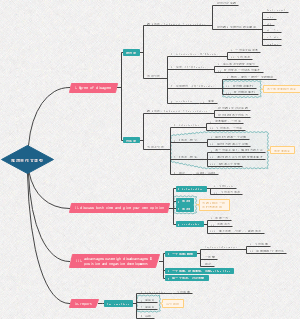导图社区 Critical Thinking and Critical
- 292
- 15
- 8
- 举报
Critical Thinking and Critical
思辨式英文写作(南开大学)唐磊老师团队 第一课到第四课(后续继续补充)
编辑于2020-04-15 14:52:25- 相似推荐
- 大纲
Critical Thinking and Critical Writing
Lesson1 Critical Thinking and Critical Writing
What is critical thinking?
a judgment that is based on good reasoning
a self-regulatory judgment
practical skills
interpretation:
clarifying meanings and understanding significance
analysis:
discovering the elements, causes, ralations, pros and cons
evaluation:
assessing arguments, reasons and evidence
inference:
drawing conclusions
explanation:
making argument
self-regulation:
examing one's own thinking
What is critical writing?
characteristics
arguing for a view point
analyzing reasons and providing evidence
responding to conflicting ideas
usages in acdemic settings
writing tests
application letters
course papers
book reviews or movie reviews
survey reports
The relationship( critical thinking to critical writing)
quality content
Language workshop(word choice)
clarity
cut unnecessary words
use words accuratly
don't use slang
slang
informal
typical spoken
special words
used by specific groups
avoid cliches
cliches
unoriginal or predictable phrases
fomality
avoid phrasal verbs
avoid subjective words
Lesson2 Understanding Arguments and Essay Structure
What is an argument?
issue
position(thesis)
reasons(premises)
logic
no emotion
no intutions
no personal preference
What is the structure of critical eaasy?
introduction
to introduce the issue
to present the thesis
body(premises)
an overall argument
contributing arguments
contradictory arguments
conclusion
to re-emphasize the overall arguments
Language workshop(effective use of verbs)
What are verbs?
verbs are action words
verbs describe the action that is taking place
action verbs show movement and help readers to imagine an activity
Importance of verbs
to show readers what action the subject is performing in the sentence
to deliver important information in a sentence
to add impact and purpose
to make sentences and statements more concise and persuasive
effective use of verbs
replacing forms of be verbs with action verbs
子主题
子主题
considering active vs. passive voice
active voice
clear, direct and concise
passive voice
used in three situations
the person responsible wishes to remain unknown.
the one who does the acton is known
the writer wants to place emphasis on an important word
in scientific writing
helps to create the appearance of an objective, fact-based discourse
Lesson3 Writing Theses and Introductions
Types of theses
theses of cause and effect
theses of policy
Thesis atatement
establish an issue
be both specific and broad
be not to specific nor to broad
take a strong position
interpret the facts of the issue
analyze the situation(be comprehensive)
evaluate the alternatives
infer from the evaluation
self-regulation
Writing introductions
functions: to make life easier for the reader
to introduce the topic
techniques
state the topic directly
the top-down method
begin with an anecdote or a brief narratiove
begin with an interesting description
ask an intriguing question
begin with a surprising atatistic or striking bit of history
dispute a common belief or defying a steretype
use famous quotation
to present the thesis
to provide a roadmap for the reader
Language workshop(periodic vs. loose sentences)
loose sentences
effect
easily understood
natural
direct
disadvantages
reader may refuse reading the suppplementary part
the main point might be forgotten
dull if repeatedly used
periodic sentences
effect
suspense, dramatic
literary
persuasive(forcing the reader to read the modifiers)
disadvantages
difficult to understand
requires attention
pompous(not natural)
Lesson4 Reasoning and Paragraph Writing
what is reasoning?
justification of a thesis with reasons and evidence
Evidence
materials used as evidence
statistics and other numerical data
information gathered through the senses of sight
information collected from books, publications, the testmony of experts
methods to get evidence
to the print and electronic sources
books
j
子主题
子主题
direct observation,survey, experiments, personal experiences
Explaining
tell how or why something has pahhened
part of reasoning as evidence
tips
ask the wh-questions: how an event has happened
ask why-questions for serveral times: deeper or real cause of something
Patterns of reasoning
thesis→reason→evidence
the reasons and the evidence are combined
thesis→evidence→reason
evidence→reason→thesis
Paragraph writing
unity
one main idea/ thesis(topic aentence)
reasoning
reasons, evidence, explanations
ways to present evidence
quotation: reproduce another person's words exactly
Paraphrasing: put others' words into your own words
summary: good for long texts or an entire book
hard facts directly: statistics, charts, photographs, examples, etc.
coherence
following the reasoning pattern
using transitional words)
Language Workshop
(use concrete and specific language)
Why?
to communicate effectively and precisely in critical writing
What is it?
excludes more than is includes(a dozen vs. a few)
How to make it?
use details→by asking yourself 5W+ 1H questions
use hyponyms( the specific words thst belong to a general category)
examples
plant
tree
flower
rose
lily
vegetable
cabbage
carot
smile/ laugh
chuckle: smile quietly or with restraint
giggle: laugh nervously or foolishly
grin: laugh pleasantly with the lips drawn back to show the teeth
guffaw: laugh loudly/ boisterously
titter: laugh in a half-suppressed and silly way
smirk: smile affectedly or derisively
sneer: smile contemptuously
snicker: laugh covertly and disrespectfully
beam: smile cheerfully with lips upward
cackle: smile over other's misfortune with mouth open, sounding like a hen









